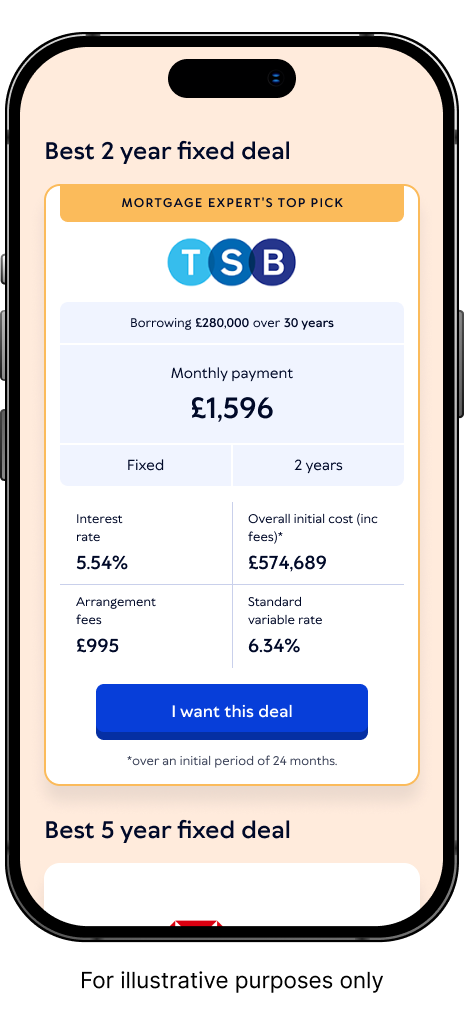- Uswitch.com>
- Mortgages>
- First Time Buyer Mortgages
First-time buyer mortgages
Looking to buy your first home but not quite sure where to start? Here’s the information you need to know when becoming a first-time buyer.
Let our award-winning broker partner Mojo find the best first-time buyer mortgage for you from the latest deals in July 2025:
Free expert advice from advisers with access to over 70 lenders, who can the best rates for you
Find out how much you could borrow with a mortgage in principle
4 out of 5 first-time buyer mortgage applications through Mojo are successful*


What is a first-time buyer mortgage?
A first-time buyer is someone who’s never bought a house before. First-time buyers generally have access to the same mortgage deals as other buyers, although some lenders offer mortgages tailored towards them.
You’re classed as a first-time buyer if you:
Have never owned of part-owned a home before, anywhere in the world
You won’t be classed as a first-time buyer if you:
Have ever owned or part owned a home anywhere in the world
Have inherited or had a home bought for you, even if you've now sold it
You’re buying jointly with someone who has previously owned a property
Get a mortgage in principle
Our trusted partner Mojo Mortgages helped over 8,500 first-time buyers in 2024 - are you ready to discover your mortgage options too? Start your mortgage journey by getting an expert-verified mortgage in principle to find out how much you could borrow.
How to get a mortgage as a first-time buyer
Figure out your finances
The best time to apply for a mortgage is when you’ve saved up the money you need for a deposit and you’re in a stable financial position. You should feel comfortable handling your mortgage repayments (and all the other costs associated with buying a house!)
Mortgage providers will assess your affordability and the risk of lending to you during the application process. So, to get an idea of how a lender might view you, check your credit rating and get some tips on how to boost your score before applying.
Get your mortgage in principle
Find out how much a lender might be willing to offer you by getting a mortgage agreement in principle (also known as an agreement in principle or decision in principle). While it doesn’t guarantee a lender will give you a mortgage, knowing how much you can borrow can help you search for properties within your budget - and you may find estate agents won’t even let you view properties without one.
Find your dream home
With your mortgage in principle sorted, it’s time to find a house you love and put an offer in. While you’ll want to buy your dream home first time, it’s common to have to compromise on at least one element, such as considering a more affordable area or a smaller home than you initially planned.
Compare first-time buyer mortgages
Once you know which property you want to buy, get in touch with your lender or broker to find out what mortgage options are available to you. When you work with a broker, you’ll get a tailored recommendation from across many first-time buyer mortgage deals.
Submit a formal mortgage application
It’s time to gather everything you need for your mortgage application, including proof of identity, proof of your current address, proof of income and three to six months' of bank statements. If you work with a broker like Mojo, they'll handle all the mortgage application paperwork for you - for free! At this stage, your lender will conduct an in-depth assessment, including a hard credit check and property valuation.
How much can I borrow as a first-time buyer?
Most lenders base loan size on a multiple of your annual income. This is typically between four to four-and-a-half times what you earn, according to recent mortgage statistics. The fact that you're buying for the first time won't usually make a difference.
Lenders also look at your affordability, however, which is not quite as straightforward as your income. They'll need to weigh your income against any debts and regular expenses you have.


Many first-time buyers often just consider the property value when working out how much they can afford. But there are estate agent fees, conveyancing fees and moving costs to think about too. It’s also worth being aware of the most recent Stamp Duty changes, which could add extra costs to your move.”Laura Hamilton, Mortgage Expert
How much deposit do I need for a first-time buyer mortgage?
The deposit you need typically depends on the lender and the type of mortgage you are applying for, but most lenders require a deposit of at least 5% of the property value.
If you can afford a larger deposit, and therefore bring your loan-to-value (LTV) ratio down, you may be eligible for more competitive mortgage rates though. This could result in lower monthly payments.
Let’s take a look at how much deposit you would need per LTV, in order to buy an average home* in the UK.
*Average property value taken from Zoopla’s House Price Index, February 2025
| Average property value | Deposit percentage | Actual deposit needed |
|---|---|---|
| £267,200 | 5% | £13,360 |
| £267,200 | 10% | £26,720 |
| £267,200 | 15% | £40,080 |
| £267,200 | 20% | £53,440 |
Which first-time buyer mortgage is right for me?
There are a range of mortgage products out there that could be suitable for first-time buyers.
Fixed-rate mortgage
The interest rate is ‘locked in’ for a specific period on a fixed-rate mortgage deal, usually between 2 and 10 years. Typically, the initial interest rate is higher than on a variable rate deal.
The main advantage of a fixed-rate mortgage is that you’re protected from external factors, such as rising interest rates. The downside is that you won’t benefit if rates fall. When a fixed-rate mortgage deal ends, you’re moved onto the lender’s standard variable rate (SVR) unless you choose to remortgage.
Variable-rate mortgage
With a variable-rate mortgage, your interest rate can vary over the duration of the deal. While this means your interest should fall if rates fall, so you’ll pay less each month, if rates rise they can become expensive.
There are three main types of variable-rate mortgages:
Tracker mortgages: the rate is usually set at a certain percentage above the Bank of England base rate. Every time the base rate rises or falls, the interest you pay will change.
Discount-rate mortgages: the rate is set at a certain percentage below your lender’s standard variable rate (SVR) for the duration of the deal so, when the SVR changes, your mortgage interest and repayments will change too
Standard variable rate mortgages: the interest rate is set at the lender’s discretion, and may change at any time. A lender’s standard variable rate is normally much higher than other deals available on the market.
Some variable-rate mortgages come with caps, which means that the amount you pay each month will never rise above a certain level. They can also come with collars, which means that your interest rate can never fall below a certain amount.
Offset mortgage
Offset mortgages use your savings to reduce the amount of interest you pay each month. If you have substantial savings, they are kept in linked account(s), and lenders deduct the value of them from your mortgage balance before charging interest.
Some providers also allow family offset mortgages, where a family member can use their savings to reduce the amount of interest you pay.
What Government schemes are available to help first-time buyers?
It can be difficult to save a deposit for your first home in the current financial climate, but there are a range of government schemes available to help first-time buyers.
Shared ownership - allows you to buy between 10% and 75% of a property and pay an affordable rent on the remaining share
First homes scheme - allows first-time buyers and key workers earning below £80,000 (£90,000 in London) to purchase a new-build home for 30-50% less than their market value
Right to buy / Right to acquire - local authority (council) and housing association tenants may be able to buy their homes at a discount on the market value
Lifetime ISA - provided you meet the eligibility requirements, you could pay up to £4,000 into your Lifetime ISA account every tax year and receive a 25% bonus from the government each year too
What are my other options as a first-time buyer?
Struggling to step foot on the property ladder? These mortgage options might be suitable for you.
Guarantor mortgage
A guarantor mortgage allows another person to use their own property or savings as collateral for your mortgage. If, for whatever reason, you have trouble repaying, the lender can ask your guarantor to step in.
95% mortgage
A 95% mortgage is a popular option for first-time buyers, as it gives you the option to provide a lower deposit of just 5%. This can help you buy a house faster, rather than facing delays saving up for a larger down payment.


Your individual circumstances, such as financial stability and mortgage preferences, will always determine which is the 'best mortgage' for you. A whole of market mortgage broker can help you review all of the options available to you, and sometimes has access to offers you won't find yourself. ”Jason McDonald, Mortgage Expert

Your credit score can impact the mortgage you’re offered
Getting your first mortgage? It could be useful for you to have a clearer idea of your credit score before you apply. When you speak to one of Mojo’s expert mortgage brokers, they’ll run a mortgage eligibility check to find out how much you might be able to borrow and which lender could be most suitable for you. Your broker may also get a copy of your credit report, so they can offer tips on ways to strengthen your application. Don’t worry - they’ll use a soft credit check, which means there’s no impact on your credit score.
Efficient and stress free

Jonathan was very professional,he…

Liam was absolutely fantastic from…

First-time buyer FAQs
Do you pay Stamp Duty as a first-time buyer?
As a first-time buyer in England and Wales, you’re eligible for a Stamp Duty discount.
If the property is worth £300,000, you pay no Stamp Duty Land Tax (SDLT) at all.
If the house costs between £300,001 and £500,000, you pay SDLT at 5% on anything over the £300,000 threshold.
If the house costs more than £500,000, you don’t benefit from the discount.
The rules in Scotland are different, but first-time buyers can still get a discount, with the zero-tax threshold at £175,000.
Welsh first-time buyers do not benefit from a Land Transaction Tax (LTT) exemption, but you won't pay any LTT on properties under £225,000.
It's important to note that if you're buying with someone else who has previously owned a property, this will forfeit your first-time buyer status.
Can I get a first-time buyer mortgage with someone else?
Yes, it is possible to get a joint mortgage as a first-time buyer which will allow you to buy jointly with up to three other people with some lenders.
If you’re a first-time buyer but the person you’re buying with isn’t, this could impact your eligibility for some first-time buyer benefits. For example, you won’t be eligible for the First Homes scheme or first-time buyer Stamp Duty tax relief if the person you’re buying with has owned a property before.
What other costs should I consider as a first-time buyer?
It’s important to budget for the full costs of home ownership, rather than just your mortgage repayments.
Home and contents insurance, average utility bills and council tax can all be researched prior to selecting a home, to help you not to take on more than you can manage. We've also compiled a list of the fees involved with the home buying process:
Mortgage arrangement fees, sometimes referred to as a product fee
Legal costs including conveyancing and land search fees
Home insurance. Most lenders will insist that you have buildings insurance as a part of the mortgage terms and conditions. Contents insurance is not required, but it is recommended
Property survey. This pays the lender's fee to ensure that your chosen property is worth the value that you've offered
Stamp duty. In England and Northern Ireland you won’t pay any on your first home, so long as it costs below £300,000. Different stamp duty rules and terminology apply in Scotland (LBTT) and Wales (LBT).
*81% of the mortgage applications submitted by Mojo Mortgages for their first-time buyer customers have resulted in an offer in the last twelve months. Correct as of 5 June 2025.
YOUR HOME/PROPERTY MAY BE REPOSSESSED IF YOU DO NOT KEEP UP WITH YOUR MORTGAGE REPAYMENTS.
The FCA does not regulate mortgages on commercial or investment buy-to-let properties.
Uswitch makes introductions to Mojo Mortgages to provide mortgage solutions.
Uswitch and Mojo Mortgages are part of the same group of companies. Uswitch Limited is authorised and regulated by the Financial Conduct Authority (FCA) under firm reference number 312850. You can check this on the Financial Services Register by visiting the FCA website.
Uswitch Limited is registered in England and Wales (Company No 03612689) The Cooperage, 5 Copper Row, London SE1 2LH.
Mojo Mortgages is a trading style of Life's Great Limited which is registered in England and Wales (06246376). Mojo are authorised and regulated by the Financial Conduct Authority and are on the Financial Services Register (478215)
Mojo’s registered office is The Cooperage, 5 Copper Row, London, SE1 2LH. To contact Mojo by phone, please call 0333 123 0012.



